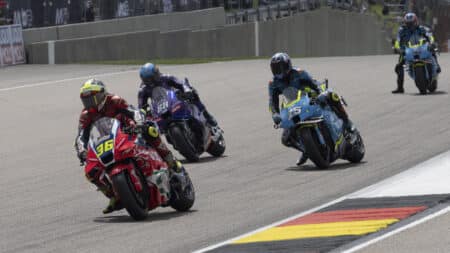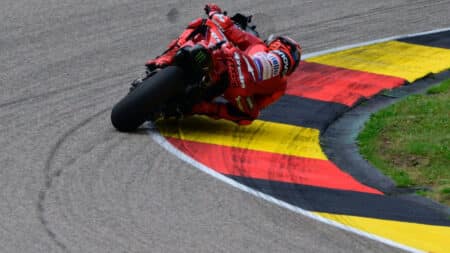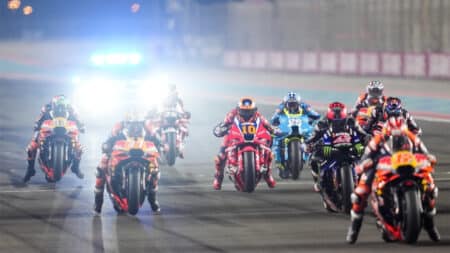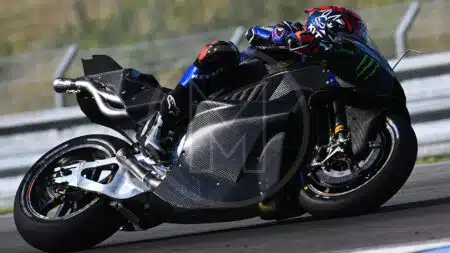When the future looks uncertain, some people like to take refuge in the past, which goes some way to explaining the success of events like last weekend’s Goodwood Festival of Speed, which is largely about old motor sport metal.

The metal is all important because, unlike most sports, motor racing has a hugely tangible history: gawping at the goal posts used at the 1938 FA Cup final is never going to be as much fun as examining the supercharged DKW that won the 1938 Lightweight TT.

Among those paying homage to the past at Goodwood was Valentino Rossi. The (currently uncrowned) king of MotoGP jetted in from Saturday’s Dutch TT, still giddy on the taste of his 111th Grand Prix victory, to take part in celebrations marking Yamaha’s 60th anniversary.
Unlike most racers, Rossi has always been interested in racing history. He knows plenty about the old days and goes misty eyed when he talks of the scary 500cc two-strokes he rode at the turn of the millennium and of the early days of MotoGP, before hi-tech electronics suppressed some of the skills he had laboriously and painfully learned.
Like most top MotoGP riders, Rossi would prefer fewer electronic controls, because he enjoys riding the bike himself and would rather use his skills to make the difference over rivals.
Next year, for better or worse, that’s exactly what he will get. Dorna’s new unified software, currently only used by Open bikes, commenced its takeover of the entire MotoGP grid at 00:00 hours this morning, when factory teams had their own software frozen, banning all development prior to the introduction of the control ECU at the first winter tests.

I’m like The Fast Show‘s Indecisive Dave when it comes to MotoGP’s unified software: when someone tells me it’s a great idea I nod vigorously, and when someone tells me it’s an appalling idea I stroke my chin and nod sagely.
MotoGP’s biggest bullshit?
This is what a top MotoGP electronics engineer – who shall remain nameless – thinks…
“The control ECU is the biggest, biggest, biggest bullshit that’s ever happened in the paddock. The manpower cost may go down by 50 per cent but the cost of simulation will go up by 100 per cent. With limited functionality from the software you have to spend time on the simulator to run all the possibilities of all the settings to find which setting will give you the most advantage.
“Last year’s Open-class traction control had one-and-a half tables of numbers; now it’s six tables, and all these tables work into each other, so we spend a whole day only on fine tuning, then another day for every track and another day for every condition. Magneti Marelli claim the system is so clever but it’s so old-fashioned. They have no idea. They speak so nice, they sound so clever, but it’s all hot air. It makes me so angry!

“We should keep the control ECU, but let people write their own software as they do now – it’s more cost efficient. If you are working on the traction control to avoid big slides, the control ECU has five tuning parameters for every point – like speed, rpm, torque, spin and so on – so how can one man in a small team set that up? Already the number of total parameters are increasing, from 1500 last year to 2000 this year.
“They say that the unified software will reduce the gap between the big teams and the small teams, but it won’t. The factory teams can afford the manpower, so they will have one engineer working on the traction control, another on the wheelie control, another on engine-braking control, another for the carburation. And what will the private team have? One guy working on all of these on his own! It’s ridiculous!”
Obviously, as Indecisive Dave, I believe every word of this. And I believe MotoGP’s Open riders who complain about this year’s system, which will essentially be the same system used by Rossi, Marc Márquez and everyone from the post-Valencia GP tests onward.

Or is it all operator error?
Next, I wander to the other side of the paddock, to the Dorna offices, for a chat with MotoGP director of technology Corrado Cecchinelli. He insists that any problems encountered by the Open teams are down to operator error.

“This is because their technicians are not properly calibrating the system – there is a difference between a wrong strategy and a wrong calibration,” he says. “Last year we introduced to the Open ECU a difference between left and right lean, so the traction control can do different things on lefts and rights, because this is necessary. Having the possibility to make the difference between lefts and rights opens the door to an improvement in performance, or more mistakes.”
I believe this, too. And yet I’m reminded of our anonymous electronics engineer explaining how the rich teams can afford small armies of electronics engineers to get the best out of the control ECU, while the poorer teams are overwhelmed and make mistakes.
To freeze or not to freeze?
All the factories are now working on the 2016 unified software, at least in their race departments. Dorna gave them the dyno strategies (fuelling and ignition) in April and the chassis strategies (traction control, wheelie control, launch control etc) were delivered last week.
And the factories don’t actually have to freeze their own software. They only have to give up tweaking their own electronics if they want to join in development of the unified software.

“Ducati, Honda or Yamaha must freeze their software if they want to sit at the evolution table where they can improve the unified software,” adds Cecchinelli. “But they don’t have to sit at the table if they want to continue development of their own software until the end of the season. Let’s assume manufacturer A wants to add something to the traction-control strategy that isn’t in the current universal software, they have to tell manufacturers B and C that they would like to introduce a new strategy, so they have to disclose their strategy. This is why all factories at the table must freeze their electronics, otherwise they could copy that strategy into their own system for the rest of the year.”
Initially only Ducati, Honda and Yamaha will be involved in this process because they were the factories who agreed to accept unified software. Aprilia and Suzuki can do whatever they like for the rest of this season.
Exactly how is this going to work?
Cecchinelli believes the three top factories will freeze their software and throw their lot in with the control ECU, but will they, because who would sacrifice winning today for winning tomorrow? If Yamaha, Honda or Ducati think they can gain an edge in the second half of this season, will they really renounce that in the hope of better performance in 2016?
And how much will the factories want to cooperate on development of the unified software from next year, because what’s the point of suggesting an improvement when rivals will also benefit from that improvement? Cecchinelli thinks that for this reason the unified software could remain unchanged for a long while.

“I think the manufacturers will never find an agreement on anything!” he adds. “The way it will work is that if they have a unanimous proposal to change something in the software, then we must introduce it. All changes to the software must be agreed unanimously by all the manufacturers. But if they never find an agreement on anything, the software will stay the same forever.”
Now I’m not sure who I agree with; but whatever happens it’s going to be fascinating watching the dawn of MotoGP’s new electronics era.













